M.M. Perry's Blog, page 6
November 23, 2016
New Cover Art!
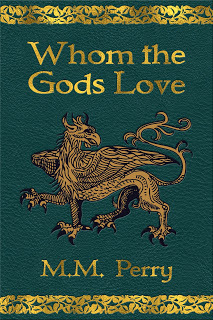 You'll be noticing new cover art for Whom the Gods Love and Whom the Gods Hate if you've purchased them. I tried fiverr, and so far that was a bit of a bust. I still have a couple people who should get back to me, so maybe I'll still get something out of it yet. We'll see. I am thinking of making a post about what that was like. I read quite a few blog posts about fiverr that were older, and things have changed on that site since those posts, so maybe some would be interested in an update on the fiverr experience. But for now I made my own covers. I am by no means a graphic artist, or even a Photoshop expert. But hopefully these are a little nicer than my first attempts. Here is the first new cover. In the next couple of days I'll post the cover for the third title of the trilogy, Whom the Gods Fear.
You'll be noticing new cover art for Whom the Gods Love and Whom the Gods Hate if you've purchased them. I tried fiverr, and so far that was a bit of a bust. I still have a couple people who should get back to me, so maybe I'll still get something out of it yet. We'll see. I am thinking of making a post about what that was like. I read quite a few blog posts about fiverr that were older, and things have changed on that site since those posts, so maybe some would be interested in an update on the fiverr experience. But for now I made my own covers. I am by no means a graphic artist, or even a Photoshop expert. But hopefully these are a little nicer than my first attempts. Here is the first new cover. In the next couple of days I'll post the cover for the third title of the trilogy, Whom the Gods Fear.
Published on November 23, 2016 09:01
November 21, 2016
Long Hiatus - Back in Business!
 It's been a while. A little over a year ago today I had my port taken out. The last couple of years have been, well, let's just say interesting. After everything was said and done, I was left with catching back up to my life.
It's been a while. A little over a year ago today I had my port taken out. The last couple of years have been, well, let's just say interesting. After everything was said and done, I was left with catching back up to my life.This is just a quick post to let everyone know, the third book in the series I have written, Whom the Gods Fear, is currently about 80% edited. I have to get a cover together and get it up on Amazon. It will go up, hopefully shortly after Christmas. I'd say before, but I don't want to do that and then not make a deadline. When I release Whom the Gods Fear, I intend to also bundle up Whom the Gods Love and Whom the Gods Hate into a collection that will be at a discounted price, so future readers can get the whole set or the individual books.
I also have two books finished in a new sci fi series I'll be debuting early next year. I've been busy, as you can guess. In a couple weeks I'll post part of the first chapter of the new series, so you can get a feel for it. Until then, here is a picture of a fractious cat. (I know he's fractious, because it says so on his vet summary.)
Published on November 21, 2016 12:02
May 4, 2014
Spring update
 I'm posting a quick update on my progress on Whom the Gods Fear. It's in the editing stage now so we're getting really close to a completion date. I know it's a little early to be talking about what I'll be getting to next once the Tanavian Chronicles come to a close. This trilogy has been a lot of fun to write but I'm ready to do another single volume work again. My next book will be science fiction. It's a departure from what you are used to, but I assure you, sci fi is my favorite genre. It's always been a little surprising to those who know me that I wrote fantasy first, but those were the stories that spoke to me at the time, so that's what I decided to write.
I'm posting a quick update on my progress on Whom the Gods Fear. It's in the editing stage now so we're getting really close to a completion date. I know it's a little early to be talking about what I'll be getting to next once the Tanavian Chronicles come to a close. This trilogy has been a lot of fun to write but I'm ready to do another single volume work again. My next book will be science fiction. It's a departure from what you are used to, but I assure you, sci fi is my favorite genre. It's always been a little surprising to those who know me that I wrote fantasy first, but those were the stories that spoke to me at the time, so that's what I decided to write.When more of the book comes into shape, I'll post a chapter so readers can get a feel for my sci fi writing style. I hope you enjoy it as much as my fantasy. I've had some questions about whether or not I'd ever return to Tanavia once I finished the trilogy. I've not ruled it out, of course, and if a story inspired me, of course I'd write it and publish it. Tanavia is a rich world with a deep mythology. I may indeed return to it one day. For now, I hope you enjoy the end of the current story arc.
My next blog entry will have another lovely piece of fan art from the book Whom the Gods Hate. I can't wait to show it to you. Until then, enjoy the spring!
Published on May 04, 2014 10:57
January 7, 2014
Brrrrr!
 It's been a while since I posted an update. Now that the holidays are over and the uncontrollable-teeth-chattering cold has set in, I'm back indoors and in full gear finishing up the final book in the Tanavian Chronicles. It seems hard to believe Whom the Gods Hate was only published a little over 4 months ago and I'm already rapidly nearing the point where I'll begin editing on the final book of the series. I'm just that excited to finish the story for everyone.
It's been a while since I posted an update. Now that the holidays are over and the uncontrollable-teeth-chattering cold has set in, I'm back indoors and in full gear finishing up the final book in the Tanavian Chronicles. It seems hard to believe Whom the Gods Hate was only published a little over 4 months ago and I'm already rapidly nearing the point where I'll begin editing on the final book of the series. I'm just that excited to finish the story for everyone.Back to winter, which I'm sure at this point many are bemoaning. I've always liked winter. I know at times like this it can be hard to appreciate the coldest of seasons (having spent the day digging out my walkway bundled in every layer of clothing available to me... trust me, I fully condone the griping), but winter is the necessary evil I gladly submit to in exchange for the turning of the seasons. We couldn't have fall, my favorite season, without the winter. I do also enjoy snow, particularly the way it drastically changes the landscape around us overnight. If nothing else, Jack Frost's belligerent attitude trapping me inside is the perfect excuse to get my body back inside and my mind back in Tanavia. So with that, I'll get back to it. Until next time!
P.S. check out the fantastic tribute to Calvin and Hobbes there! It's one of the best of the Calvin inspired snow art found here.
Published on January 07, 2014 17:53
October 29, 2013
National Cat Day
 Yes, it's true. Today is national cat day. It is the day we worship our overlords, those fuzzy little rumbling creatures that order us about on a daily basis. So much so, they even created their own day. Surprisingly, we don't seem to mind that much.
Yes, it's true. Today is national cat day. It is the day we worship our overlords, those fuzzy little rumbling creatures that order us about on a daily basis. So much so, they even created their own day. Surprisingly, we don't seem to mind that much.You may recognize this little ruffian from my profile picture. This is one of most bossy bosses. She rules the house.
In honor of National Cat Day, I'm choosing a glossary entry on a creature of the feline persuasion. Again, this creature is mentioned and has some importance in Whom the Gods Hate, but there isn't as much described in the book as there is in my glossary. While this cat might not be as likeable as the smaller versions we're used to seeing in a cozier setting, it will have to do.
Protean LionsProtean lions are twice the size of their nearest relatives, but that is not where the danger lies--protean lions have the ability to change their color. Their coat is composed of clear hairs, each of which picks up its color from the skin beneath, which can change color subtly to match protean's environment. The protean's range of colors isn’t as dramatic as some of the lizards of Tanavia, limited to shifting among blacks, browns, greys, whites, and any of the shades in between. They also have fine tuned enough control of their color-shifting that they can form splotches on their skin making them look like they are covered in dappled shadow. They are excellent predators, often killing prey before they are ever noticed. They hunt from natural ditches, log hallows and trees. They are also known to occasionally hunt in some of the taller grassed plains, but they prefer to stick to forested areas. They will hunt and kill almost anything that is not significantly larger than them. Proteans tend to stick to hunting grazing animals but have been known to take down the unwary human now and again. While they typically avoid humans massed in large numbers, they will attack individuals or small groups without hesitation. Unless fully equipped, a group of five or six humans can be and often is taken down if they encounter a protean. Proteans store what they don’t eat in one sitting in trees or occasionally in small ditches. Even a fully equipped, well seasoned group of a half dozen encountering a protean is likely to lose at least one or two members before the creature falls. This is due to the difficulty in landing a killing blow on the swift creature. Their necks are quite muscular, and few sword blows could penetrate deep enough in one blow to fell the beast. Spears can be used to pierce the heart, but the accuracy required to land such a blow in the face of a charging protean is rare. Other than their ability to change their coats, protean lions have the same general characteristics of other large cats. They are solitary, and do not gather in packs like some great cats. Further, they are highly territorial, with ranges that can extend for several miles. They are not common, live in isolated areas rarely frequented by humans, and only hunt when hungry, so reported attacks on humans are infrequent. Note the term, “reported.” As the beasts are so adept at killing before they are ever seen, many unexplained disappearances in unpopulated areas should rightly be attributed to the protean.
Published on October 29, 2013 22:08
October 21, 2013
On art and insects
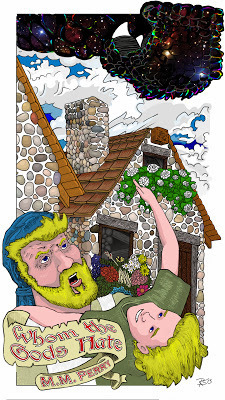 I got a nice surprise this weekend. A reader sent me a lovely drawing of a scene from the newest book, Whom the Gods Hate. This awesome picture was too good to keep for myself, so I asked if it was okay to include on my blog. Permission granted, so here it is. The original is very large, so hopefully this squished little blog version does it some justice. I love the comic book style. It reminds me of those Prince Valiant comics that were in the Sunday comics when I was a kid - those may still be in the Sunday comics but it's been years since I've picked up a newspaper. Thank you, super fan!
I got a nice surprise this weekend. A reader sent me a lovely drawing of a scene from the newest book, Whom the Gods Hate. This awesome picture was too good to keep for myself, so I asked if it was okay to include on my blog. Permission granted, so here it is. The original is very large, so hopefully this squished little blog version does it some justice. I love the comic book style. It reminds me of those Prince Valiant comics that were in the Sunday comics when I was a kid - those may still be in the Sunday comics but it's been years since I've picked up a newspaper. Thank you, super fan!I'm roughly a third of the way done with the final book in the trilogy. It's coming along nicely. I'm excited to complete the story of these adventurers for you. In the meantime, here is an entry from the glossary on a creature that plays a small part in the newest book, Whom the Gods Hate. This insect gets mentioned in passing and has some "screen time," but I go into more detail in my glossary about the little beastie than in the book.
Husks – Husks are an insect like creature about the size of a dog. They have long legs and thin, brown bodies with dark non-uniform spots. Husks usually live in small hives of twenty to thirty individuals. They build their brown wood-like nests high in trees. The hives are hard to spot as the husks use tree bark to create their nests which acts as a natural camouflage. The name Husks comes from what they do to their prey. They are blood drinkers and will attack large animals in groups, draining them completely leaving behind “nothing but the husk,” as the saying goes. Though they do not desiccate their prey, it has long been misperceived that they do. Rather, the drained body decomposes strangely due to the anticoagulant the husks inject into their prey. The anticoagulant coincidentally draws moisture to the surface of the body making the body dry out in a short period of time. Husks are dangerous to any travelers who enter woodlands where they are known to live, but due to their specific requirements – they have trouble living in lower altitudes and warmer climates -- they are not a prolific species.
Published on October 21, 2013 18:13
September 11, 2013
Whom the Gods Hate Now Available!
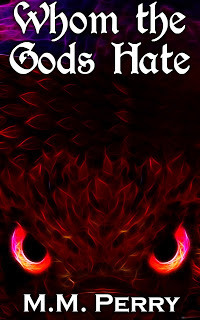 Apologies for the late publishing. A confluence of unfortunate events was determined to derail my plans this summer. Now, finally, I've managed to get everything in order and publish Whom the Gods Hate the sequel to Whom the Gods Love. In celebration of the release of the second book in the trilogy, Whom the Gods Love will be free for 48 hours starting tonight at midnight. If you haven't had a chance to pick up the first book, during the promotion would be a great time to do that.
Apologies for the late publishing. A confluence of unfortunate events was determined to derail my plans this summer. Now, finally, I've managed to get everything in order and publish Whom the Gods Hate the sequel to Whom the Gods Love. In celebration of the release of the second book in the trilogy, Whom the Gods Love will be free for 48 hours starting tonight at midnight. If you haven't had a chance to pick up the first book, during the promotion would be a great time to do that.As I mentioned before, I've already begun writing the third and final book in the trilogy. With luck, I should be done with the next book before the new year and ready to edit it. Being the final installment in the trilogy doesn't necessarily mean I'll never revisit Tanavia, but I have so many ideas for new books that I think I'll take a break from the world of Tanavia for a while and explore some other worlds.
I hope that everyone enjoys Whom the Gods Hate and I look forward to bringing the story to an exciting close for everyone. I'll be back next week with another entry from the glossary and more news. Thanks for reading!
Published on September 11, 2013 20:24
July 22, 2013
Deathsglove
The video is of several slime molds and fungus in time lapse. The slime mold in particular influenced my ideas for the subject of this post. As I was going over the final comments on Whom the Gods Hate, I picked an entry for readers to chew on while they wait for the release of the book. Deathsglove makes an appearance in the upcoming book but I don't go into as much detail in the book as I do in the glossary. This is common with the flora and fauna of the world of Tanavia. I typically have a much lengthier description in my glossary than anything in the narrative. I do this mainly because it wouldn't really fit the flow of the story to stop and have the characters discuss the history of a particular flower or fish but I use it for my own reference to the world. Sometimes the characters might discuss something about a plant or animal at length if it seems natural, but more often than not they don't.
Deathsglove – the name given to a species of lichen that is highly aggressive and omnivorous. Deathsglove was only discovered in the last hundred years. It lives in natural caves formed underground by flowing water. The lichen is a single organism in each cave system it inhabits. It can flow slowly over time through the smallest cracks and will do so if it senses nutrition in another cave system. There is a history of a cave village at the base of the Grey mountain range in Ledina. The whole village was destroyed by the deathsglove organism that made it into their cave system. All that remains in the village are its structures--even the lichen left the village once it leeched all the nutritive elements within it. Deathsglove is a pale green color, often mistaken for white. It looks slimy and innocuous, lining cave walls and floors. Its appearance belies its extremely dangerous nature. It is highly toxic, delivering strong neurotoxins on contact, rendering them unable to move within seconds. It can be alternately sticky and slippery depending on its needs. For instance, when lining a cave floor it might make that part of itself slippery. Once its prey has slipped and fallen onto a larger patch, it will change its nature to become so sticky nothing has been known to escape it. It then proceeds to slowly devour its prey, covering it completely over time. The prey generally dies within a few days of being captured. The deathsglove has been known to allow the prey to rot, leaving parts of the body so as to attract further prey. Nothing is above being eaten by deathsglove. Everything from small flies to humans are consumed by the lichen. Deathsglove is one of the reasons people now avoid dwelling in caves on Tanavia. Any opening that may lead deeper into the earth could potentially be a passageway for the deathsglove to traverse. Once tales of the lichen spread, people became wary of it. It invades slowly enough that once noticed a mining operation, for instance, can shut down in time to escape harm. Caves that have been known to house deathsglove are marked heavily with carvings all around the entrance. Even if it looks as if the lichen has been gone for years, these caves are only used with great caution, as the lichen can re-infest at any time. Deathsglove cannot poison a person through heavy boots and thick clothing that has been treated with the sap of the iron bark tree. However, the lichen need only touch its prey directly on its skin for a second for the toxin to get into the system. The lichen can leech through untreated clothing without much trouble. The neurotoxin is highly valued by hunters, though gathering it has a high mortality rate. Understanding this, only those wishing to harvest from the lichen brave the caves with the warning symbols carved on them. Gatherers always go in groups of two or more, since there is no known way to escape the deathsglove once one has been captured. Those captured are killed by their partners to avoid the agony of a days long death.
Deathsglove – the name given to a species of lichen that is highly aggressive and omnivorous. Deathsglove was only discovered in the last hundred years. It lives in natural caves formed underground by flowing water. The lichen is a single organism in each cave system it inhabits. It can flow slowly over time through the smallest cracks and will do so if it senses nutrition in another cave system. There is a history of a cave village at the base of the Grey mountain range in Ledina. The whole village was destroyed by the deathsglove organism that made it into their cave system. All that remains in the village are its structures--even the lichen left the village once it leeched all the nutritive elements within it. Deathsglove is a pale green color, often mistaken for white. It looks slimy and innocuous, lining cave walls and floors. Its appearance belies its extremely dangerous nature. It is highly toxic, delivering strong neurotoxins on contact, rendering them unable to move within seconds. It can be alternately sticky and slippery depending on its needs. For instance, when lining a cave floor it might make that part of itself slippery. Once its prey has slipped and fallen onto a larger patch, it will change its nature to become so sticky nothing has been known to escape it. It then proceeds to slowly devour its prey, covering it completely over time. The prey generally dies within a few days of being captured. The deathsglove has been known to allow the prey to rot, leaving parts of the body so as to attract further prey. Nothing is above being eaten by deathsglove. Everything from small flies to humans are consumed by the lichen. Deathsglove is one of the reasons people now avoid dwelling in caves on Tanavia. Any opening that may lead deeper into the earth could potentially be a passageway for the deathsglove to traverse. Once tales of the lichen spread, people became wary of it. It invades slowly enough that once noticed a mining operation, for instance, can shut down in time to escape harm. Caves that have been known to house deathsglove are marked heavily with carvings all around the entrance. Even if it looks as if the lichen has been gone for years, these caves are only used with great caution, as the lichen can re-infest at any time. Deathsglove cannot poison a person through heavy boots and thick clothing that has been treated with the sap of the iron bark tree. However, the lichen need only touch its prey directly on its skin for a second for the toxin to get into the system. The lichen can leech through untreated clothing without much trouble. The neurotoxin is highly valued by hunters, though gathering it has a high mortality rate. Understanding this, only those wishing to harvest from the lichen brave the caves with the warning symbols carved on them. Gatherers always go in groups of two or more, since there is no known way to escape the deathsglove once one has been captured. Those captured are killed by their partners to avoid the agony of a days long death.
Published on July 22, 2013 20:58
July 10, 2013
Whom The Gods Hate To Be Published Soon!
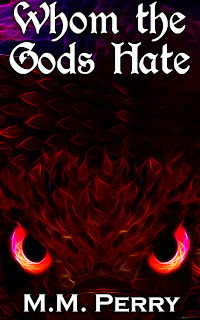 Final editing is done on the second book of the Tanavian Chronicles trilogy. I'm now waiting for a couple people to return their comments to me and then I'll be ready to publish. In the meantime I have already started the next and final book in the trilogy. I've finished the first chapter and added a slew of new entries into my glossary. I wanted to get a quick start on the new book for a couple of reasons. First and foremost, I know as a fan of series fiction that waiting for the conclusion to something can be agonizing. It is my dream that my readers will come to feel that passionately about my writing. I know, that's probably not the best thing to hope for--the suffering of my readers, waiting, desperate for new material and hopelessly addicted to my novels--but I promise if that is where we end up, I won't punish you with the waiting. Not too much, anyway. Finally, I wanted to make sure I kept the rhythm of the story going and maintain strong continuity.
Final editing is done on the second book of the Tanavian Chronicles trilogy. I'm now waiting for a couple people to return their comments to me and then I'll be ready to publish. In the meantime I have already started the next and final book in the trilogy. I've finished the first chapter and added a slew of new entries into my glossary. I wanted to get a quick start on the new book for a couple of reasons. First and foremost, I know as a fan of series fiction that waiting for the conclusion to something can be agonizing. It is my dream that my readers will come to feel that passionately about my writing. I know, that's probably not the best thing to hope for--the suffering of my readers, waiting, desperate for new material and hopelessly addicted to my novels--but I promise if that is where we end up, I won't punish you with the waiting. Not too much, anyway. Finally, I wanted to make sure I kept the rhythm of the story going and maintain strong continuity. Let's get back to Whom the Gods Hate, which should be out real soon. I've got a small teaser for you. I won't include the glossary entries just yet, as that might give too much away. This book features several new types of creatures and beings, a couple of which have been mentioned in Whom the Gods Love. The characters will also be traveling to new continents as well; much more of Tanavia is explored. The second book continues the tradition of the first book in that it's a traveling tale with more of the myths--my favorite parts of these books. For next week, I'll try to choose a glossary entry that won't spoil too much. Until then!
Published on July 10, 2013 19:59
June 11, 2013
New Book Announcement!
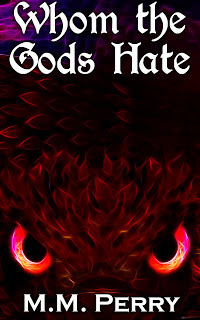 Whew! It's been a while, and I apologize, but I've been working really hard on finishing up the sequel to Whom the Gods Love. I'm excited to say the book is finished! I'm currently about half way through the final edits of Whom the Gods Hate - I send it off to friends and relatives to spot check for errors and the like - and as soon as that gets done, it will be published on Amazon. Here is the cover for you to enjoy. In the coming weeks I will be posting some excepts from the new book as well as some more glossary entries for you to peruse while you wait. I'm hoping for a mid-July release date. Until next week!
Whew! It's been a while, and I apologize, but I've been working really hard on finishing up the sequel to Whom the Gods Love. I'm excited to say the book is finished! I'm currently about half way through the final edits of Whom the Gods Hate - I send it off to friends and relatives to spot check for errors and the like - and as soon as that gets done, it will be published on Amazon. Here is the cover for you to enjoy. In the coming weeks I will be posting some excepts from the new book as well as some more glossary entries for you to peruse while you wait. I'm hoping for a mid-July release date. Until next week!
Published on June 11, 2013 17:33



